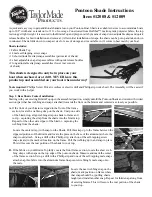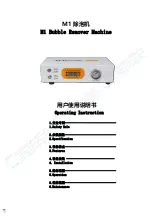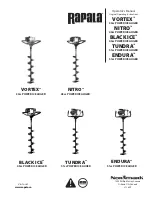
6009-33 Broadband At Sea
Maintenance and Troubleshooting
7-12
The output port of the coax switch is connected to the L-band port Pedestal M&C Mux, to provide Co-Pol or
Cross-Pol LNB output, of the selected frequency band, through the receive channel of the rotary joint to
below decks via the receive IF coax cable.
There are three controls applicable to the LNB's installed on this system; 1 operational voltage selection, 2
operational tone control and selection of Co-Pol OR Cross-Pol Receive IF. Voltage and Tone, used to select
the frequency band of the LNB, are supplied to the LNB which has been selected by the Co-Pol/Cross-Pol
switch. DC voltage is supplied by the pedestal modem and Tone is supplied by the tone generator. The Band
and Polarity of the Receive IF is selected by the Tracking Band setting in the ACU. Your service provider will
determine which frequency band and whether to use Co-Pol or Cross-Pol for normal operation. The chart
below may be used to determine what tracking band setting to utilize and only applies when the “TrackDisp”
parameter is set to 0130 (refer to chapter 5 for detailed information on this parameter).
Tracking Band Setting
Tone, LNB Voltage & Switch state
Receive IF Polarity
Xp B1
Tone OFF, Volt 13, Aux 0
Cross-Pol Band 1
Xp B2
Tone ON, Volt 13, Aux 0
Cross-Pol Band 2
Xp B3
Tone OFF, Volt 18, Aux 0
Cross-Pol Band 3
Xp B4
Tone ON, Volt 18, Aux 0
Cross-Pol Band 4
Cp B1
Tone OFF, Volt 13, Aux 1
Co-Pol Band 1
Cp B2
Tone ON, Volt 13, Aux 1
Co-Pol Band 2
Cp B3
Tone OFF, Volt 18, Aux 1
Co-Pol Band 3
Cp B4
Tone ON, Volt 18, Aux 1
Co-Pol Band 4
The Transmit IF and a 10 MHz reference signal is generated from the below decks satellite modem after a
positive Rx lock has been established. These signals are then routed through the transmit path of a dual
channel rotary joint via coax to a power supply where 48Vdc is injected and passed to a Block Up Converter.
The BUC then up converts (hi-side injection) and amplifies the IF signal and routes the resultant RF to the Tx
port of the diplexer via waveguide. The diplexer passes the RF through to its’ common port and then is
routed to the transmit port of the feed (OMT) via waveguide.
7.4.2.
Series 09 TXRX Antenna Initialization
Turn the pedestal power supply ON. The brakes on the Elevation and Cross-Level motors will release. Brake
release power supply control circuit supplies 24 VDC to the brakes initially (5-10 seconds) and then reduces
the voltage to 12VDC. The PCU will initialize the stabilized portion of the mass to be level with the horizon
and at a prescribed Azimuth and Elevation angles. The antenna will go through the specific sequence of steps
(listed below) to initialize elevation, cross-level and azimuth to predetermined starting positions.
Initialization is completed in the following phases, each phase must complete properly for the antenna to
operate properly (post-initialization). Observe the Initialization of the antenna pedestal.
Step 1. Elevation axis then activates - Input from the LV axis of the tilt sensor is used to drive the
Elevation of the equipment frame to bring the tilt sensor LV axis to level. This step takes
approximately 10 seconds and will result in the dish being at 45.0 degrees in elevation. The level
cage may still be tilted left or right at this time.
Step 2. Cross-Level axis activates - Input from the CL axis of the tilt sensor is used to drive Cross-
Level of the equipment frame to bring the cross-level axis of the tilt sensor to level (this results in
the tilt of the Cross-Level Beam being level). This step takes approximately 10 seconds.
Step 3. Azimuth axis activates - Antenna drives CW in azimuth until the “Home Flag” signal is
produced. This signal is produced by a Hall Effect sensor in close proximity to a Magnet. After
another 10 second wait, the antenna will report its version number at the Antenna Control Unit
(ACU).
This completes the phases of initialization. At this time the antenna elevation should 45.0 degrees and
Relative azimuth should be at home flag (home switch hall sensor at the magnet in the azimuth driven
sprocket).
If any of these steps fail, or the ACU reports model "xx09", re-configure the PCU as described in the
Maintenance section of this manual. If initialization still fails, this indicates a drive or sensor problem, refer to
the Troubleshooting section.
PRELIMINARY
Summary of Contents for 6009-33
Page 3: ...PRELIMINARY ...
Page 4: ...PRELIMINARY ...
Page 8: ...6009 33 Broadband At Sea Introduction viii This Page Intentionally Left Blank PRELIMINARY ...
Page 18: ...6009 33 Broadband At Sea Installation 3 6 This Page Intentionally Left Blank PRELIMINARY ...
Page 66: ...6009 33 Broadband At Sea DRAWINGS 9 2 This Page Intentionally Left Blank PRELIMINARY ...
Page 68: ...PRELIMINARY ...
Page 72: ...PRELIMINARY ...
Page 73: ...PRELIMINARY ...
Page 75: ...PRELIMINARY ...
Page 77: ...PRELIMINARY ...
Page 79: ...PRELIMINARY ...
Page 81: ...PRELIMINARY ...
Page 83: ...PRELIMINARY ...
Page 85: ...PRELIMINARY ...
Page 87: ...PRELIMINARY ...
Page 88: ...PRELIMINARY ...
Page 89: ...PRELIMINARY ...
Page 91: ...PRELIMINARY ...
Page 93: ...PRELIMINARY ...
Page 95: ...PRELIMINARY ...
















































